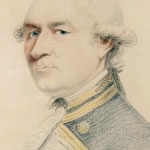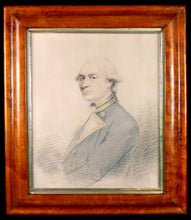Portrait of Captain Sir Richard Pearson R.N. - Nemesis of Captain John Paul Jones, U.S.N., Circa 1810
Adding product to your cart
Overall: 33cm (13in) x 28cm (11in)
Watercolour, pencil and crayon on paper. Attributed to Joseph Slater. Framed back to back with an accompanying watercolour portrait of Margaret, Lady Pearson, signed and dated ‘J. Slater, 17 Newman Street, London 1810’.
Read more
On 23 September 1779, during the American Revolutionary War, Pearson in the frigate H.M.S. Serapis, 50-guns, was escorting a large convoy from the Baltic when he was attacked off Flamborough Head by an American squadron of five warships led by John Paul Jones in U.S.S. Bonhomme Richard, 42-guns. Shortly after 7pm Serapis and the 22-gun hired ship Countess of Scarborough placed themselves between the convoy and Jones's squadron, allowing the merchantmen to escape. Serapis and Countess then exchanged fire with Bonhomme Richard and U.S.S. Alliance, 36-guns. With the weight of metal favouring the British and the wind dying, Pearson issued a demand for the American surrender but received in reply Jones’s famous retort ‘I have not yet begun to fight!’ Thereafter Serapis and Bonhomme Richard grappled in a deadly struggle with Jones’s deck guns and marines in the rigging clearing Pearson’s decks. Alliance sailed by and recklessly fired a broadside into both ships. Meanwhile, U.S.S. Pallas, 32-guns had enticed Countess of Scarborough downwind of the main battle and joined by Alliance forced her to surrender. With Bonhomme Richard on fire and sinking, Pearson struggled to establish if Jones had struck his colours and tried to board but the attempt was thwarted when a grenade caused the explosion of a large quantity of powder on Serapis's lower gun-deck. Alliance then returned to the fray, firing two broadsides. Again, these damaged both battling ships and persuaded Pearson nothing further could be achieved by prolonging the battle. With Bonhomme Richard fatally damaged, most of her crew transferred to Serapis, which under Jones’s command, conveyed Pearson as a prisoner to Holland.
Sir Richard Pearson (1731–1806) was born at Langton Hall, Appleby, and entered the Royal Navy in 1745. Limited prospects caused him to take service in the East India Company until 1755 when he passed for lieutenant. He distinguished himself in the Seven Years’ War in the East Indies and was severely wounded. He was subsequently unable to obtain a commission because his senior officers twice died before they could fulfil their promises. He finally obtained post rank as a captain in 1773. Pearson's spirited action off Yorkshire coast was widely recognized and on his release from captivity in France he was knighted by George III. On hearing of the honour conferred on his adversary, John Paul Jones's remarked: ‘Should I have the good fortune to fall in with him again, I'll make a lord of him.’ Pearson further received the freedoms of several towns and was feted by the London merchants whose ships he had saved. He retired from the service in 1790 and in 1800 became Lieutenant-Governor of Greenwich Hospital in succession to Captain William Locker.
Joseph Slater (circa 1779-1837) began his career as a portrait painter in London, first exhibiting first at the Royal Academy in 1803. He worked principally in pencil, crayons and watercolour, as can be seen in his 1813 portrait of Admiral Lord Gambier which is stylistically similar to the present work [NPG 1982]. The present portrait, however, is possibly a posthumous one, worked up by Slater in 1810 from Charles Grignon’s oil portrait of 1780 [NMM BHC2942] or from James Watson’s mezzotint thereof. Evidence for this may be found in Pearson’s outdated uniform. In Grignon’s portrait, Pearson wears the 1774-87 pattern full dress uniform coat with white lapels of a Captain R.N. (with three years’ seniority). In 1795 this changed to blue lapels and the coat was embellished with epaulettes. Furthermore the tie-wig worn by Pearson in Grignon’s portrait was an anachronism by the early 19th century, having fallen out of favour after the imposition of William Pitt’s Powder Tax of 1795. Moreover the subject arguably looks the same age in both pictures. The National Maritime Museum has questioned the origin of the Pearson portrait that appeared in the ‘Naval Chronicle’ in 1810 [PAD3096]. Here, we believe, is the answer.






